The tonal wonders of the fretless electric guitar and bass
Fretless instruments are not new to the musical zeitgeist. Several have existed over the centuries, from the zither to the oud. These are the instruments that made their melodies what they are, allowing for microtonality and precision of notes in the hands of true masters. Many of these more “exotic” instruments came from the eastern countries, such as Turkey, Egypt, Syria etc. where music and melodies don’t follow western classical traditions. In western music, you have a variety of stringed orchestra instruments, from the violin to the viola. From the cello to the double bass. The lack of frets, like their eastern brethren, allows for the precision of note and tuning in the hands of great players. These instruments have also found their way into popular music, from the double bass being a mainstay in jazz and roots music to their electric fretless versions made popular by players like Bill Wyman (who arguably created the first fretless electric bass) and Jaco Pastorious.
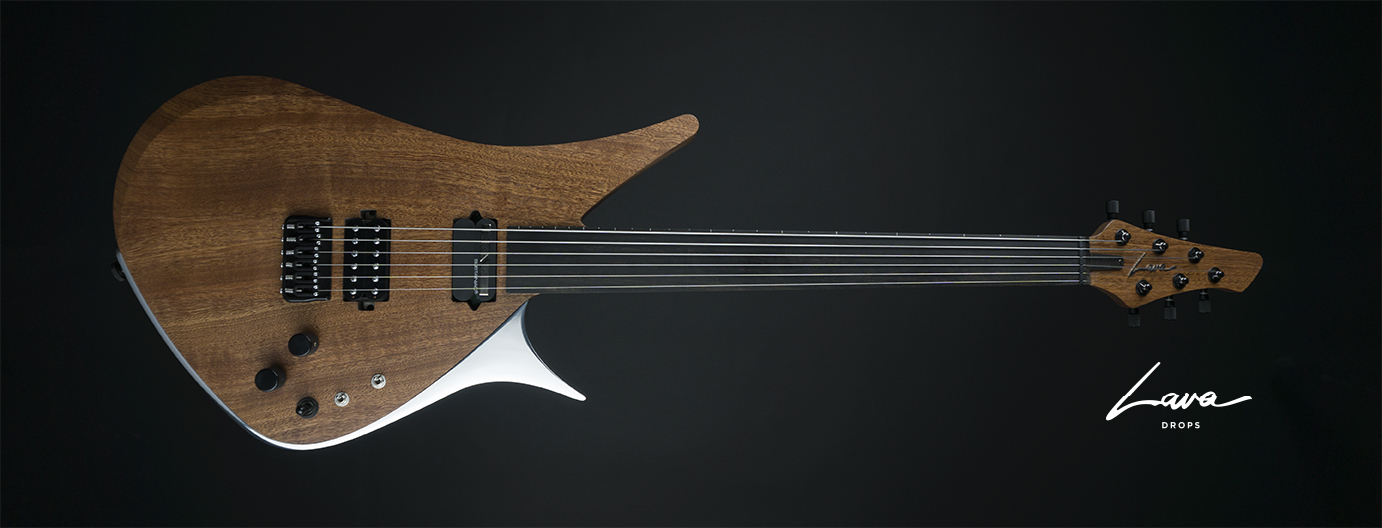
Meanwhile, fretted instruments are wide and common, with several variations to the design from fanned frets, to true-temperament frets (the squiggly ones, for lack of a better term). Standard frets do lock an instrument into a set temperament. It makes instruments like the guitar and bass much easier to play since there is no guesswork involved around where to place your finger on the fretboard.
For the advantages, there are trade-offs. The big one is temperament. Western music long adopted equal-temperament tuning, which allowed for 12 semitones per octave. However, experts will tell you that, mathematically, Eb and D#, though technically the same note in western tuning, are not the same. There are ever-so-slight variances. It would also mean a whole lot of other frets on the instrument, and some notes being next to impossible to play without equal temperament.
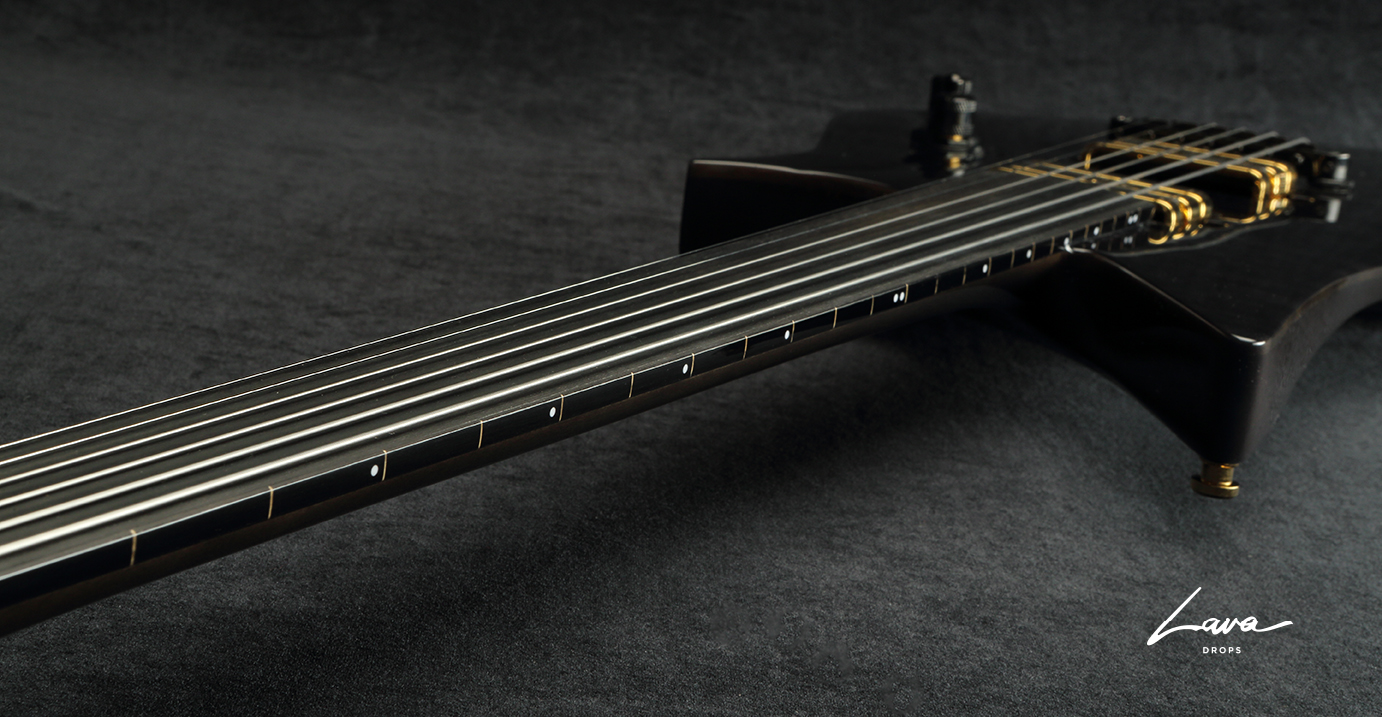
Guitarists will also experience this phenomena when fretting chords at different spots on the neck. No matter how well your guitar is tuned and intonated, some chords just sound a bit off. Some players like Keith Richards and Eddie Van Halen compensated for this by flattening or sharpening certain strings on their guitars so that chords at particular spots on the neck will sound in tune, but it’s not a complete fix for all spots on the neck. With a fretless electric guitar or fretless bass guitar, it is possible to play intervals and chords more in tune by making slight adjustments with the fingers. The lack of frets allows even the most minute changes, making chords and intervals arguably ring more true.
Fretless guitar and bass also give western players access to microtonality. Players like Jeff Beck have managed to blend eastern influences in their melodies through precise bending, or the use of the whammy bar. Fretless guitar is just another means of achieving those sounds in the same way an oud player would, for example. This unlocks a whole new level of expression.
Temperament aside, the instruments also allow a degree of expression that is not always possible on fretted instruments. Techniques like glissandos are much more smooth and more fluid. On a fretted instrument, a glissando will feature the distinct steps of the semitones as you slide up and down the neck; hardly the same effect. Now players can easily slide one line, one interval, or even a whole chord into the next.
Guitarists and bassists also have access to new vibrato techniques which are impossible on fretted instruments. The beautiful finger vibrato that string players use can easily be done on a fretless guitar or bass. Applying that technique on a fretted instrument doesn’t yield the same result, sound or width of vibrato (where the note can be vibrated on the sharp side or flat side. Fretted instruments only allow you to pull sharp, unless you bend up to the note and apply vibrato.)

Now, picking up one of these instruments is going to be an adjustment for the average player. For one, the lack of frets will test their ear. Most guitars should have position markers on the neck (on the fretboard and/or on the edge of the fretboard) to aid the player, and some fretless necks have “frets” inlaid into them to help position the fingers. The latter provides another level of adaptation as most players are used to fretting the note between the fret wire. With a fretless instrument, the finger must be played directly over the marker to be properly intonated. Vibrato also poses a bit of an adjustment. On fretted instruments, moving the string up and down on the vertical plane is quite common. This will not work on a fretless instrument because of the nature of the fretboard and the lack of frets. Players will need to apply finger vibrato, much like classical string players do, where the finger is moved back and forth on the horizontal plane.
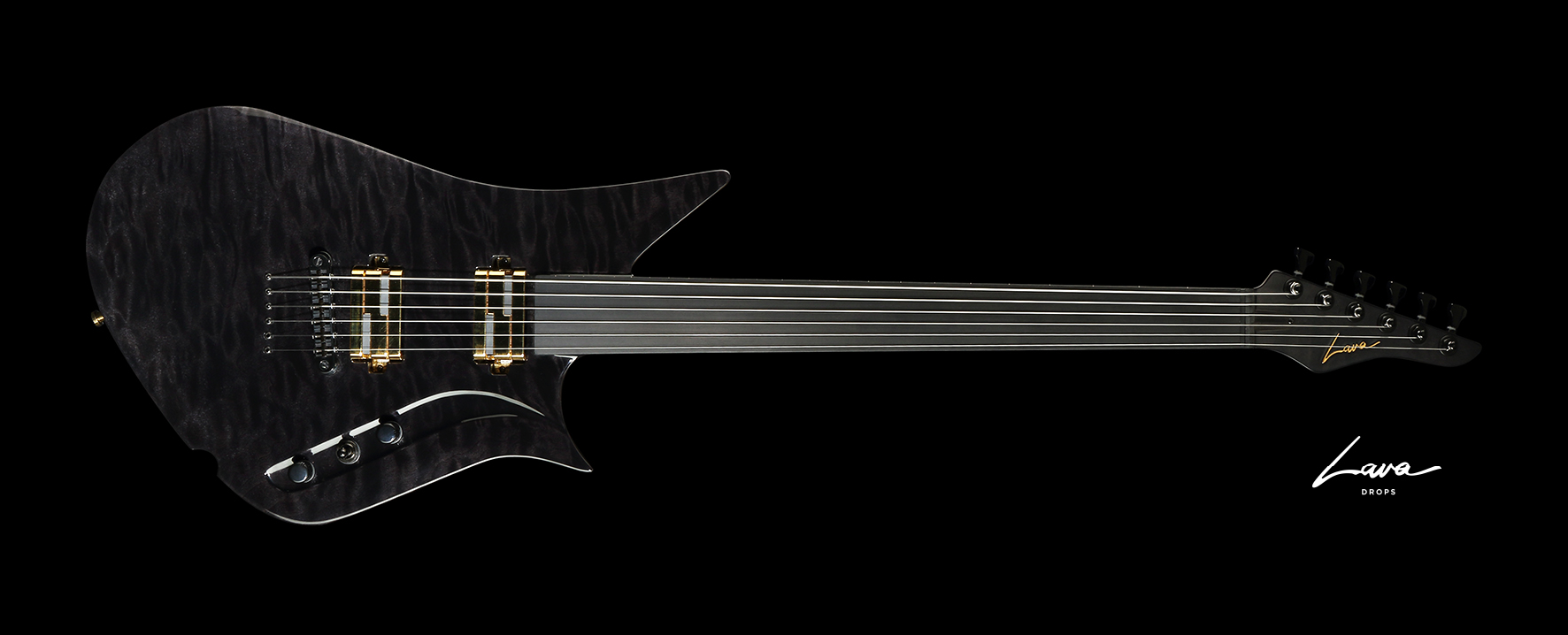
That being said, the adjustments do make the instrument worth trying. New sounds and techniques often bring new inspiration. Notes sound warmer and have that round sound to them, especially associated with fretless bass. You can also achieve real microtonality, giving melodies and an almost vocal-like quality of the note being slightly flat or sharp, then moving to pitch, with great ease.
Lava Drop guitars have been building fretless instruments since the beginning. Like with our fanned frets, any model guitar or bass with any number of strings can be ordered with a fretless fingerboard.
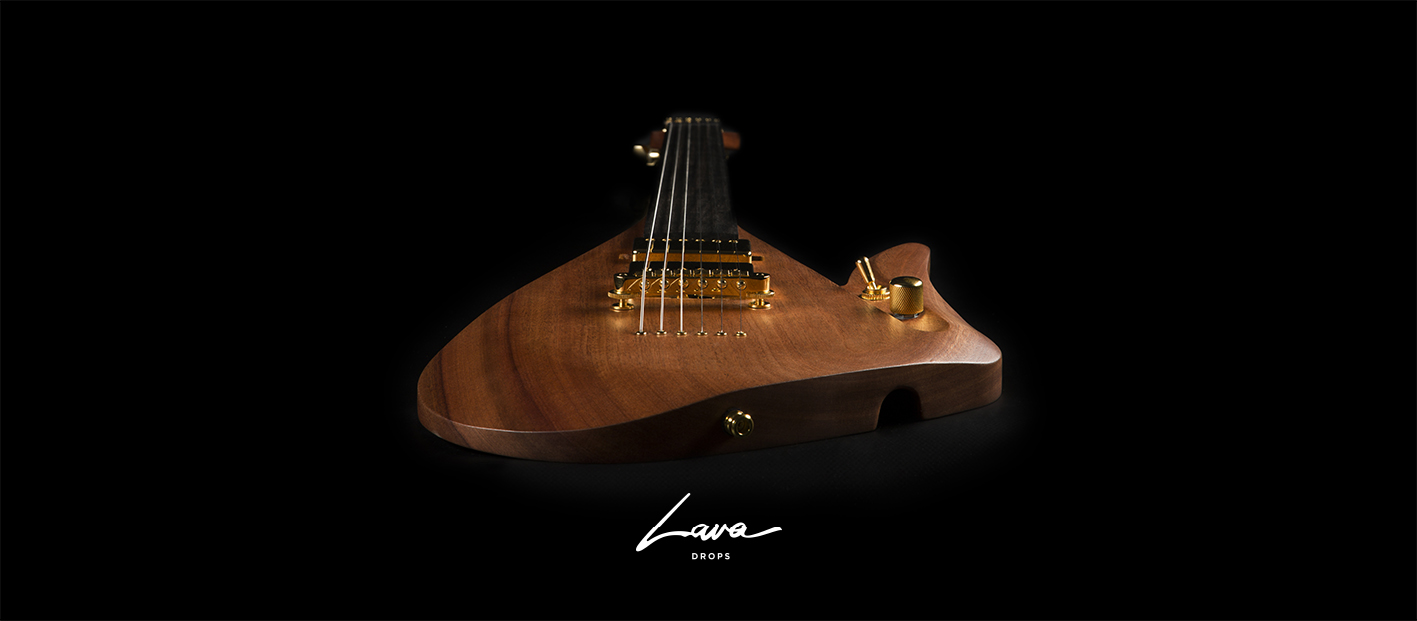
While different manufacturers use different materials for their fretboards (from wood to epoxyed wood, to metal and even glass), Lava Drops uses high-grade ebony for our fingerboards. This wood provides a warm sound to the note and keeps with the tradition of fine woods being used for fine stringed instruments. Using this wood also keeps the instruments firmly rooted in our mission to provide the ultimate marriage between the natural world and modern guitar and bass building.
If you’re in the market for a fretless electric guitar or fretless electric bass, please contact us, and let’s see what we can create for you.
The Physical Beauty of Multi-Scale on Lava Drop Guitars
There is something intriguing when you see a multi-scale guitar. After decades of seeing classic instruments with perpendicular necks and frets, seeing an instrument that has fanned frets does present an air of mysticism and sophistication, with an air of innovation. Lava Drop Guitars was founded on the basis of innovation; multi-scale necks are part of the innovation that we bring to our instruments.
So, why after years of guitars having one scale across all strings would someone choose a multi-scaled neck? The answer lies in the sound, the ergonomics and the advantages it brings to various styles of music.
Let’s start with the sound, and let’s start by considering another stringed instrument: the piano.
The beauty of the piano lies in one of nature’s greatest absolutes: physics. If you open the instrument to see the strings, you will notice that the strings for the lower pitches are much longer than the strings for the higher notes. This is due to the amount of tension that is needed to get the strings up to pitch; lower notes will always require a longer length to get the tension needed to sound right, while higher strings need less length.
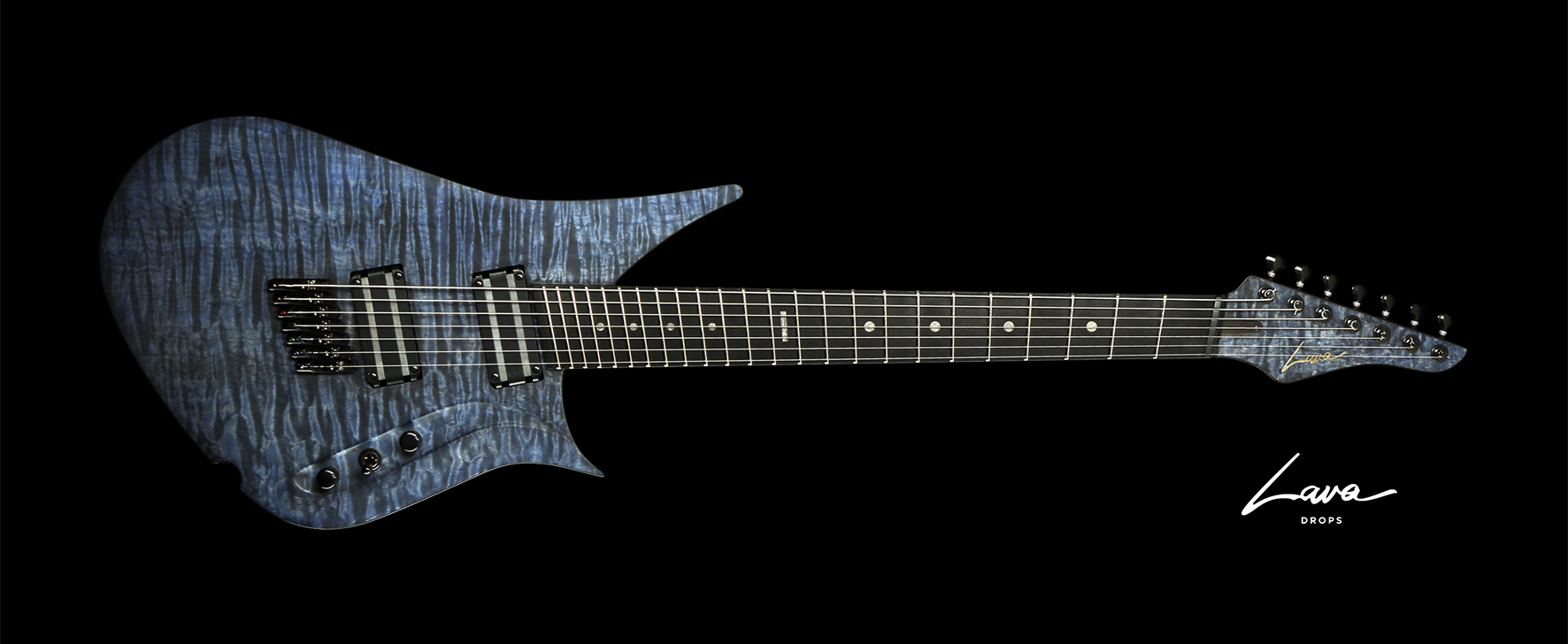
Traditionally, single-scale necks can present challenges for lower notes or those who use lower tunings. It’s no secret that the lower you tune a guitar, the looser the string becomes, sacrificing a tight sound for something that sounds “floppy” (mostly because the string is doing just that).
You can also easily see the difference the scale length can make on a regular set of 10-46 strings. These strings on an S-style or T-style guitar (which traditionally has a scale length of 25.5”) tuned to A 440 will feel tighter under the fingers than that same set of strings on an LP-style guitar (which has a scale length of 24.75”).
Multi-scale necks apply that same principle from the piano to the guitar, allowing the lower strings to be longer, tighter and more resonant, eliminating the “floppy” sound, while keeping the higher-pitched strings at a more “standard” length where they sound and play their best.
Another advantage to using a multi-scale neck is ergonomics. Some players may have a look at a multi-scale neck and immediately wonder “how am I going to play that? Are things such as barred chords going to be a challenge?” Well, the answers to those are yes, and not as much as you think it might!
The fret fanning on a multi-scale neck actually helps your hands adjust to the neck while chording. When we play certain chords at certain points of a single-scaled neck, our wrist and hand tend to crunch up, or turn in ways that don’t feel as natural, making it somewhat difficult (not to mention uncomfortable) to play, such as a barred chord above the 12th fret.

With a multi-scaled neck’s fanned frets, frets above the 12th fret will fan towards the bridge, allowing your fingers and wrist to stay in a more relaxed and natural position while playing certain chords. Barring chords at the first and second frets will also feel better since the frets also follow hand and wrist placement as they move away from the body.

These features present different advantages for various styles of music. The ergonomics allow much more ease for different passages and techniques; some of the most technical players today have created wondrous music thanks in part to the advantages that multi-scale necks provide. Bass notes are tight and focused, while the higher strings retain fantastic tone and brilliance.
Having better tension in the lower registers of the instrument means a better sound for players of heavy music. Lower riffs are much tighter, and any possibility of pitch wobble due to looser strings is all but eliminated.
And let’s not forget about the aesthetics. Multi-scale necks present something new and exciting to the eye, especially after years of seeing players perform on single-scale necks. The fanning of the frets creates a beautiful flow that compliments the bodies of our guitars. The hidden incorporation of physics continues our goal to blend nature and modern design into our instruments.
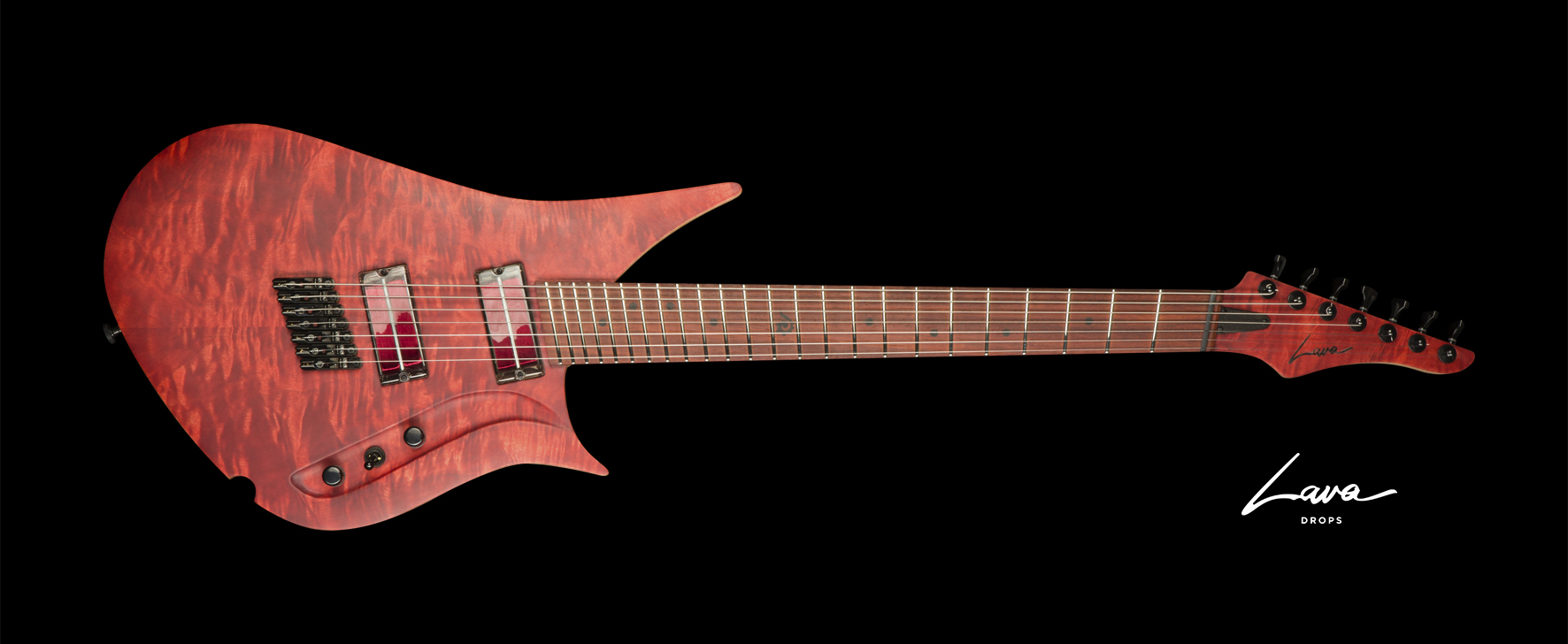
Our standard multi-scale option offers 25.5” for the high E string. To 26.5” for the lower E string for a standard 6-stringed guitar. For our basses, the scale lengths start at 34” on the G string to 35” on the E string for a 4-stringed bass.
Because our instruments are built to order, you are not necessarily limited to this. We can accommodate various multi-scale lengths for 6, 7 and 8 stringed guitars, as well as 4, 5 and 6-stringed basses. So get in touch with us and let’s see what we can create together.
How to choose the right Lava Drops model?
Lava Drops boutique guitars connect sound and design creating exclusive one of a kind functional musical art pieces to enlarge musical playability and creativity. These guitars were born in continuous explorations of undiscovered synthesis of nature and its acoustic vibrations. All Lava Drops guitars are shaped after actual physical drops to give some tangible ergonomic enhancement for a player to benefit from and in the same way represents the symbol of harmony in nature. Each Lava Drop is created from authentic and natural nature resources: from materials like 50 million years amber stones, meteorites from cosmos, exclusive and sustainable wood, bell brass, aircraft grade aluminum, different stones and materials that have their own history. Woods, other materials and metals twist into the final and unique tone. It is the elegance inspired by nature that connects the past and the future. There are 4 different concepts of these handcrafted guitar models. So we are here to help you choose the right Lava Drops guitar model for you.
4 DIFFERENT LAVA DROPS GUITARS CONCEPTS TO CHOOSE FROM
The Lava Drop - unique instrument with traditional visualization but modern approach
Lava Drop is one of the most popular guitar models that we have created and it is perfect for those who are looking for a traditional form of guitar with a modern touch. This guitar model was inspired by the ability to connect different types of wood and other materials from the earth into one fine functional piece of art and tool for the musician. Lava Drop model can be created from different natural materials and will have pure nature colours inspired by forests, mountains, blue sky, rocks, amber stone or even meteorites. One of the most exclusive variations of Lava Drop Model is created with real meteorite stone from cosmos inlays to the wood body connecting earth with space (The Deep Space Drop) or model crafted from 50 million years old amber stones from the Baltic Sea (the Black Amber Drop#1 and the Black amber Drop #2).
Lava Drop model has two horns - comfortable and ergonomic for the perfect balance, this guitar allows you to reach the highest notes easily. Also, instruments from this model are crafted with neck-through or set-neck construction which gives very long note sustain that you can feel through entire body while playing it. Lava Drop is a result of an inspiration from the nature created from different natural materials from the earth that allows you to dive into your exclusive musical journey.
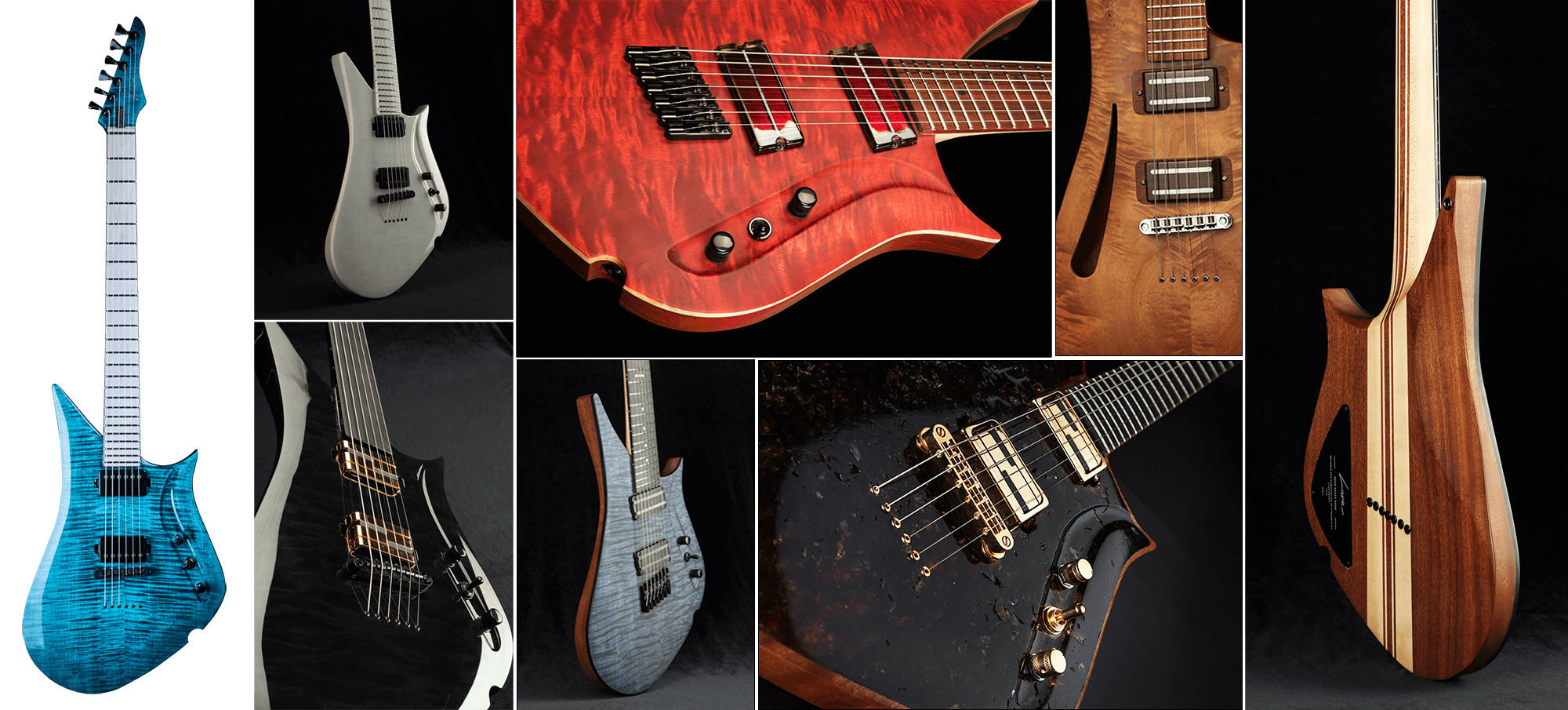
The Lava Uni Drop - the merge of classics and East culture wanting to create microtonal sounds
This is a deluxe fretless instrument model handcrafted using a neck-through construction of highest quality woods. It is created for those who love orientalism or have some passion for the East and its culture. Nevertheless this exceptional piece of art can be the instrument to anyone's musical journey who is eager to create music with microtonal sounds. The Lava Uni Drop guitar has a very slim, attenuated and ergonomic body and lighter structure with the shape of the actual Drop. It is designed to serve as an uninhibited and spontaneous source of inherent musical creativity while your fingers slide smoothly and uninterrupted from around one fingerboard side to another exploring microtones. The idea of this Lava Uni Drop guitar concept was born as a result of a desire to combine the East countries old instruments with classical string instruments trough moder electric guitar perspective. With this electric guitar everybody can create totally different sounds and music. Lava Uni Drop guitar is perfect for jazz, world-music, blues tunes or may be even for a distinctive style invented by yourself.
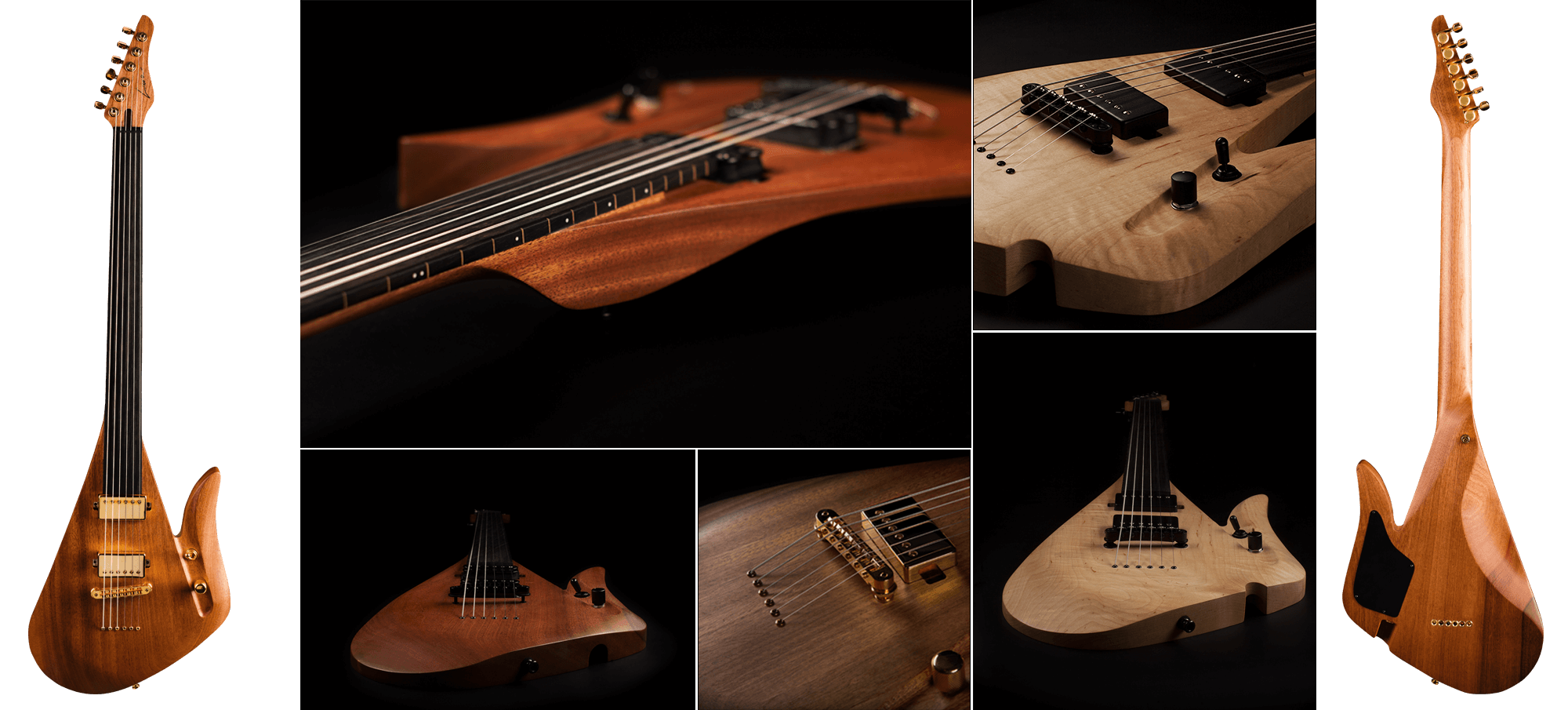
The Lava Drop X - the most modern and avant garde concept
This Lava Drops model is the most modern and futuristic musical art piece from our selection. The concept of the Lava Drop X has won the global and prestigious Red Dot Design Award. This guitar is an exceptional instrument which main body is built from Mahogany family wood, European Maple and different types of fingerboard wood including Padauk, Ebony, Pau Ferro etc. All together combined with aircraft grade aluminum contour. The harmony between warm hardwood and aircraft grade aluminum contour connect the past and the future and create unimaginable resonance and fascinating sustain at the same time giving you a very high frequency. The idea to use aluminium for the contour is one of Lava Drops Guitars signature marks. It reinforces the instrument with improved vibrations which enlarges longer sustain and gives that shining attention on the stage. Kill switch (mute button) function is also incorporated in this model. This modern, avant garde instrument is a vision of a future, it is handcrafted for exceptional musicians and will definitely remain as a family relic for a long time.

The Bass Drop X - uniqueness combining Lava Drop and Lava Drop X models together
This model was created after the idea to merge the Lava Drop ( double horn ) and Drop X models in one. Using the aluminum contour which improves the sustain of the instrument together with base material hardwoods like, Maple, Mahogany, Ash, Korina, Padauk etc. First of this model instruments was the Black Bass Aluminum Drop X - 5 string and 35 inch scale modern bass vision that could be customised according the needs. This model design could fit a Lava Drops 6,7,8 string guitars or a bass concept.
 CHOOSE LAVA DROPS GUITAR CONCEPT AND CUSTOMIZE IT
CHOOSE LAVA DROPS GUITAR CONCEPT AND CUSTOMIZE IT
Lava Drops guitars are handcrafted and created specially for you in our boutique shop in Lithuania, Vilnius/Europe. We create every piece of art with passion and attention to the details. After you choose one of the Lava Drops guitar models you can either pick from one of our already created variations that you can find on our website Premium Standard line or the Custom Gallery (which is only the very small part of what can be created) or you can have your own personal version of Lava Drop created. All of our guitars are available in different colours and different kinds of metals in a combination with a wide gallery of wood selection. If you decide to get a custom project there are many different options for your exclusive musical instrument. You can choose whether you want a Solid body or Hollow body guitar with rare and sustainable wood or even reclaimed wood combinations mainly joined by our neck-through or set-neck constructions to give a perfect balance between the endless resonating voice of the guitar and ergonomic character. Also many different incrustation variations are applicable including abalone shells, volcanic lava, meteorite from cosmos, amber stone, all sorts of wood and precious stones, metal, gold and what your vision could dictate.
You can also choose whether you want your guitar to have 6, 7 or 8 string for the solid body and 4,5,6 strings for the bass models with different fret numbers and scales (usual 25.5 inch scale or custom multi-scale options like 25.5/26.5 for the guitars and 34, 35 inch and other options including multi-scale for the Bass). We can also offer True Temperament stainless steel frets with multi-scale or usual options. Frets can be made out of Nickel Silver or Stainless Steel but it is also possible to make any model in fretless version. We always use the high end hardware parts for bridge and tuners with the colour selection that could be combined together: Black, Gold, Chrome. For the bridge selection we offer single bridges made from Bell Brass or Aluminum, Tune-o-matic style bridges with strings through body option, hardtail bridges, some tremolo systems are also available for custom projects.
Just let us know your desires, we will advise you in the best possible way and we will create the art piece that will be perfect for you and your vision.
-
THE MEDIATORS BETWEEN HUMAN AND NATURE
Lava Drops are handcrafted pieces of art with a unique approach to connect nature, music and artist. Our mission is to create instruments that reflect nature vibrations. We believe that through sound and resonance of musical instrument human can directly connect with nature and be inspired. By taking inspirations from nature organic aesthetics, joining them with modern technologies through minimal design perspective we create collectable functional musical art pieces.
With the sound and form of Lava Drops we create emotions.












 CHOOSE LAVA DROPS GUITAR CONCEPT AND CUSTOMIZE IT
CHOOSE LAVA DROPS GUITAR CONCEPT AND CUSTOMIZE IT